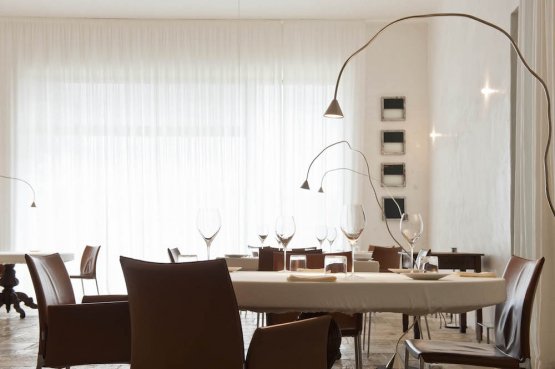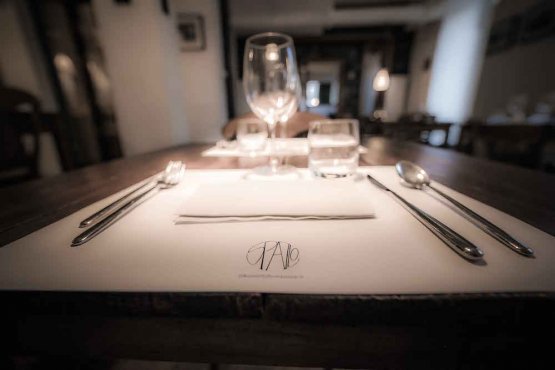see part one
Gianni Sinesi: The most important talent, the most difficult one (you cannot learn it, you must have it inside) is sensitivity applied to understanding the client: this is what leads to paying attention to details...
Cristiana Romito: ...for instance so as to note if someone is left handed and will need a different mise en place, or if someone eats slowly; the kitchen at Reale has its rhythm but as soon as we understand the type of client, we can better manage the pass, for instance by giving feedback with regards to timing as we know how long it needs to prepare and cook each dish.
G.S.: We’re the ones to set the rhythm in the kitchen. This is in fact one of the most important differences between Reale and Spazio. People go to Reale to relax and enjoy a cultural culinary experience. The dialogue between dining room and kitchen is essential at Spazio too but in this case the kitchen and dining room staff are faster on average and follow their natural rhythm.

The dining room at Castel di Sangro (photo Brambilla/Serrani)
: The initial idea for
Spazio was that the guys in the kitchen would come out and present the dishes: this still happens in Rivisondoli, at
Spazio 0, where we have never had waiters but only 16 young cooks trained in our school: the chef de partie comes into the dining room and the others follow in rotation. At
Spazio Roma there are 3 waiters plus a sommelier, with
Sabrina directing, and in Milan there are 4 waiters plus a sommelier and director
Fabio Catino. The kitchen staff there doesn’t go out (they did in Rome until recently).
G.S.: Milan is too fast. Cooks cannot go out or they’d slow down the service.
C.R.: Spazio Rivisondoli is an interesting case because we have given the kitchen staff the basic dining room skills: welcoming the guest, serving the dishes, presenting them. Alessandro De Stefanis another ex pupil at the school directs the process.
G.S.: They even had to learn to explain, present, open and serve the wine. For them I designed a simple selection of wines from Abruzzo, because the guys still want to keep a focus on the kitchen and I didn’t want to overwhelm them. At Spazio Roma the wine list is more complete, so as to satisfy a more demanding clientele: with Carlo Angelini, cellar manager, we chose a good selection of Italian wines, while as for foreign wines we chose a few bottles of champagne. Later with the dining room staff we studied a possible pairing. At Spazio Milano, where in the running I interact with sommelier Carlo Maldotti, I could instead count on my experience and the relations created over time to include a few special wines plus a few wines from Bourgogne, from villages to smaller yet important appellations.

A detail of the dining room at Spazio Rivisondoli, the restaurant born from the ashes of the first location of the Reale restaurant which moved to Castel di Sangro in the August of 2011 (photo by Francesco Fioramonti)
: The waiters at
Spazio are young; this is, on the other hand, the philosophy of
Reale as well, where the average age is 26-28. Rome and Milan share rules like collecting crumbs before the dessert, or folding the napkin when a guest leaves the table:
Sabrina wanted to convey these details of ours to her guests too, and they’re highly appreciated. Without doubt Milan has a more formal approach, closer to fine dining: for instance, they use trays and side tables to serve the dishes – and the tray has a strong impact on the client.
Spazio inherited the research in the kitchen and the quality of the service from
Reale, adapting them to the context and its rhythm, with competitive prices. In this, it is unique.
G.S.: Spazio Milano and Spazio Roma are elegant. Milan’s clientele is perhaps more international plus it’s fast: I don’t always have a chance to chat with the guests; Rome is calmer and warmer and as a consequence there’s more space for dialogue with the guests; Rivisondoli is “home”.
C.R.: The differences between the various Spazio restaurants show that as the work gradually becomes more challenging, the dining room grows in importance, and you cannot do without it. Yet the most interesting thing we’ve noted is that many cooks who also serve, have a better understanding of the restaurant’s dynamics once they’re back in the kitchen. You can’t imagine how many here at Reale now ask me to work a little in the dining room too.
G.S.: Those in our profession know both about the kitchen and the dining room.
C.R.: And a cook who understands the dining room is a better cook.
2. the end